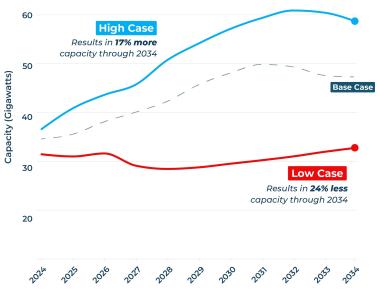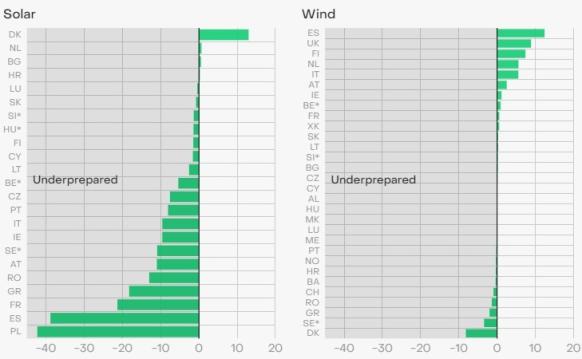US installs record 32 GW of solar; Solar in Europe soaring towards grid jam
The solar news you need to know.

Related Articles
US installs 32 GW of solar as utility-scale build surges
The U.S. installed a record 32.4 GW of solar in 2023, including 22.5 GW of utility-scale capacity, the Solar Energy Industry Association (SEIA) and Wood Mackenzie said in their latest annual market report.
U.S. installed solar capacity is forecast to hit 673 GW by 2034, compared with a current level of 177 GW, the report said, noting a 200 GW difference between its highest and lowest forecasts.
“A high case for U.S. solar with increased supply chain stability, more tax credit financing, and lower interest rates would increase our outlook 17%,” said Michelle Davis, head of global solar at Wood Mackenzie and lead author of the report.
“A low case with supply chain constraints, less tax credit financing, and static interest rates would decrease our outlook 24%," Davis said.
Forecast US annual solar installs - two scenarios
(Click image to enlarge)
Source: Solar Energy Industry Association (SEIA), Wood Mackenzie, March 2024
Texas was the largest solar market last year, installing 6.5 GW of solar compared with California's 6.3 GW.
Texas now operates 23 GW of solar power and is forecast to install a further 100 GW over the next 10 years, "outpacing the next closest state by a two-to-one margin," SEIA and WoodMac said in their report.
Meanwhile, U.S. solar module manufacturing capacity doubled last year to 16.1 GW, the report said, as projects announced on the back of the Biden administration's 2022 Inflation Reduction Act started to come online.
Record low module prices and tough economic conditions could make it difficult for manufacturers to follow through on announced facilities, the authors warned.
In 2023, prices for monofacial and bifacial solar modules fell 26% and 31%, respectively, it said.
US opens up clean energy tax credits to tax-exempt groups
Tax-exempt U.S. jurisdictions will be able to benefit from clean energy tax credits under new rules announced by the U.S. Treasury Department on March 5.
State, local, and Tribal governments, as well as Puerto Rico, the U.S. territories, and other non-taxable entities will be able to directly benefit from clean energy tax credits allocated under the 2022 Inflation Reduction Act.
The tax credits have spurred activity in solar and wind development as the Biden administration strives to meet ambitious clean energy targets.
The new rules will enable the tax-exempt parties to "build clean energy projects, lowering the cost of energy for working families and advancing environmental justice,” the American Council on Renewable Energy (ACORE) said in a statement.
To directly receive the tax credits, applicable entities can form co-ownership arrangements with private investors to produce clean power, or choose to transfer “all or a portion of their credits” to a third party in exchange for cash, the Treasury said.
As of January, 145 entities had filed requests to build 1,290 clean energy and semiconductor technology projects that would benefit from these new provisions, across 40 U.S. states.
Over 200 GW of EU solar could hit grid roadblock
Over 200 GW of solar installations in Europe could be held back by a lack of investment in new grid capacity by 2030, analysts at Ember think tank said, based on a study of 23 national grid plans.
The solar installation forecasts are based on a business-as-usual scenario set out by industry group SolarPower Europe.
Clean technology installs are set to outpace "even the most ambitious EU policy targets," Ember warned.
"Solar, in particular, is consistently underestimated in grid expansion plans compared to market outlooks...This disconnect from on-the-ground trends implies, unless remedial actions are taken, grid congestion may worsen in the short-term and larger volumes of solar capacity may become stuck in grid connection queues," it said.
Difference in EU grid plans vs solar, wind forecasts
(Click image to enlarge)
Source: Ember, March 2024
In Europe and the U.S., dwindling grid capacity and slow approval of new connections are increasing solar and wind costs and curbing growth.
The European Union recently set out 68 onshore grid projects that will gain priority access to permits and EU funding but vast amounts of investments are required across Europe's transmission and distribution networks to ensure the EU meets its climate goals.
Around half of the grid plans assessed by Ember are based on lower solar and wind deployment than national targets, Ember noted.
"Solar tends to be more affected, with its capacity underestimated by a total of 60 GW across the 11 countries, and wind by 27 GW," it said.
Reuters Events


